PPC
The Most Useful AI Features in Google Analytics 4

You already know that AI can be extremely helpful for analytics. It’s built to analyze large data sets. Which is why it’s no surprise that Google Analytics 4 (GA4) has integrated many advanced AI-driven features into its capabilities.
In this article, we’ll explore two key aspects of Google Analytics’ AI features: Predictive metrics and predictive audiences. These tools are not just about data analysis; they’re about foresight and strategy, enabling businesses to make more informed decisions.
Table of contents
How does Google Analytics 4 use AI?
Google Analytics 4 utilizes AI in two pivotal ways. The first is through predictive audiences, where AI algorithms segment users based on their likelihood of exhibiting specific behaviors, such as making a purchase or churning. This segmentation empowers marketers to tailor their strategies more effectively to different audience segments.
The second way GA4 leverages AI is through the integration of predictive metrics and segments into reports. This feature is not limited to mere predictive metrics; it also encompasses the creation of segments based on predictive data. This allows for a deeper analysis of potential customer actions, offering insights into how different segments might behave in the future.
By adding these predictive insights directly into reports, businesses gain a comprehensive view of their audience, enabling them to anticipate market trends and user behaviors with greater accuracy. This advanced functionality of GA4 marks a substantial leap forward in data-driven business strategy and decision-making.
🛑 Speaking of data-driven decisions…find out how your Google Ads are really performing with our Free Google Ads Grader
What are predictive audiences in Google Analytics 4?
Let’s start by exploring predictive audiences in GA4. This aspect to audiences is a transformative feature that, when linked to advertising accounts like Google Ads or Display & Video 360, can amplify media performance throughout the Google Marketing Platform. They’re particularly effective in similar audience targeting, retargeting, and audience suppression strategies.
Predictive audiences are constructed using predictive metrics, which are based on machine learning models that analyze user behavior patterns to forecast future actions.

Similar audience targeting
GA4’s predictive audiences augment the capabilities of Google Ads’ similar audiences by identifying the top percentage of users most likely to make a purchase. Marketers can utilize this data to target new users who share characteristics with this high-value group, optimizing reach more effectively than traditional methods such as budget increases or broadened targeting.
Retargeting audiences
Predictive audiences enhance retargeting by pinpointing users on the cusp of conversion based on their interactions, like viewing product details or cart activities. By targeting users identified as likely to convert in the short term, or those predicted as top spenders, marketers can tailor their approach to increase conversions and revenue.
Conversely, these audiences can also identify users at risk of churning. Targeting these users with specialized messages or offers can help maintain customer retention, prevent churn, and cultivate a loyal customer base.
Audience suppression
Predictive audiences can also inform strategies to suppress ads to those with a high likelihood of converting on their own, such as the top 10% of customers poised to convert soon. This allows for smarter media spend by focusing on users who may need more encouragement to complete a purchase.
⚡️ Is your Google Ads account set up for success? Download now >> The Last Guide to Google Ads Account Structure You’ll Ever Need
What are predictive metrics in Google Analytics 4?
GA4 offers three predictive metrics:
- Purchase probability: Gauges the likelihood of a user completing a conversion in the next 7 days based on their activity in the past 28 days.
- Churn probability: Estimates the chance of a user not returning to the app or site in the next 7 days.
- Predicted revenue: Projects the revenue from a user’s purchase conversions in the next 28 days.
Are you eligible to use predictive metrics in GA4?
To leverage GA4’s predictive metrics, such as purchase probability and churn probability, it’s essential to meet certain prerequisites for the machine-learning algorithms to train effectively.
Here’s what you need to configure:
- Event configuration: Ensure the ‘purchase’ event is properly configured in your GA4 property settings. This event is pivotal for the algorithms to recognize and learn from user transactions.
- Data volume: A substantial data set is required for the AI to learn from. You’ll need at least 1,000 positive (purchasers) and 1,000 negative (non-purchasers or churned users) samples. This means you should have a user base where at least 1,000 users completed a purchase and another 1,000 who didn’t after triggering the predictive condition.
- Model quality: Maintain consistent and quality traffic that generates purchase events over a minimum duration, typically a 28-day cycle. This allows the AI to discern patterns and make accurate predictions.
For each user that meets these criteria, GA4 will calculate predictive metrics daily. If the prerequisites aren’t met or if the user count falls below the required threshold, GA4 may cease to update these metrics, making them unavailable.
To monitor the status of your predictive metrics, navigate to the predictive section found within the ‘Audience builder’ of GA4. Here you’ll find ‘Suggested audiences’ templates, which provide insights into the performance and reliability of your predictions.


Predicted channel value report
We’ve talked about audiences, and it’s also important to consider how incorporating AI into your reports can greatly enhance the accuracy and insights of your analysis, especially when creating a predicted channel value report. Below is a step-by-step guide to help you integrate AI into this process.
Now, I’m creating these reports in the GA4 demo account, and I encourage everyone to explore it. Here’s a link to the demo account, which offers a great opportunity to examine real business data and experiment with Google Analytics features. Also, I walk through a version of this demo in this YouTube video.
- Once you open the GA4 property, head over to the right-hand menu of GA4, click on ‘Explore.’
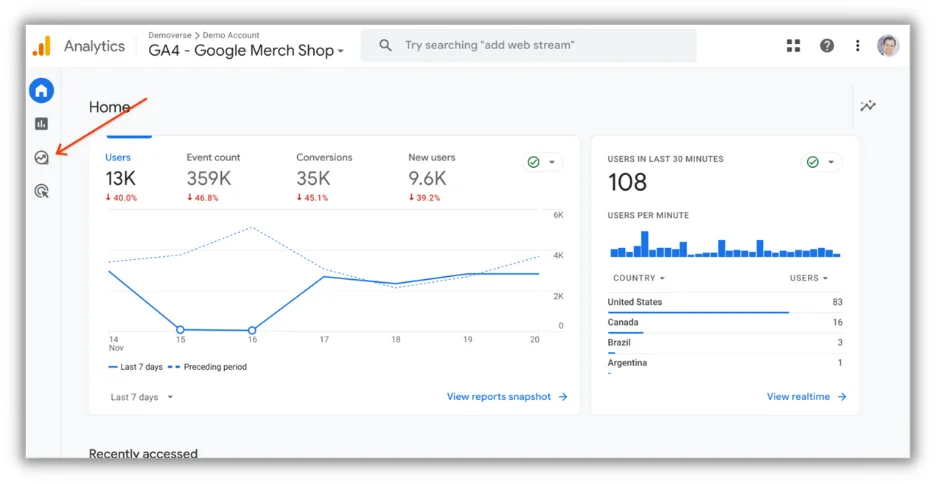

- Then click on the ‘Free form’ exploration template.
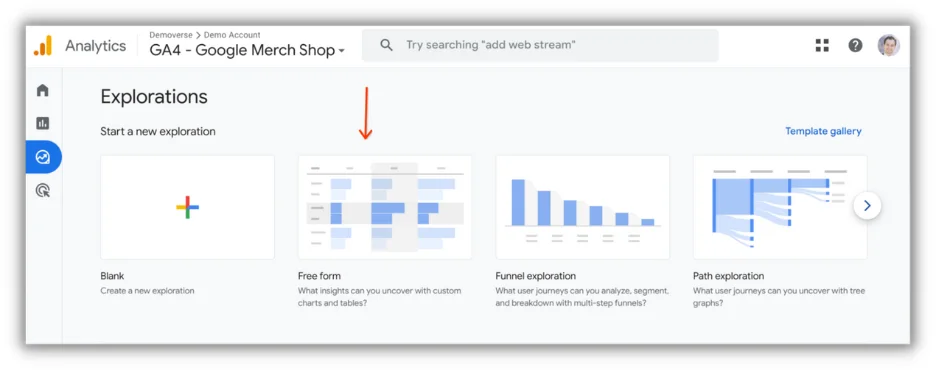

- Now, when you get to this report template, clear everything off so that you can start from scratch. It should look something like this:
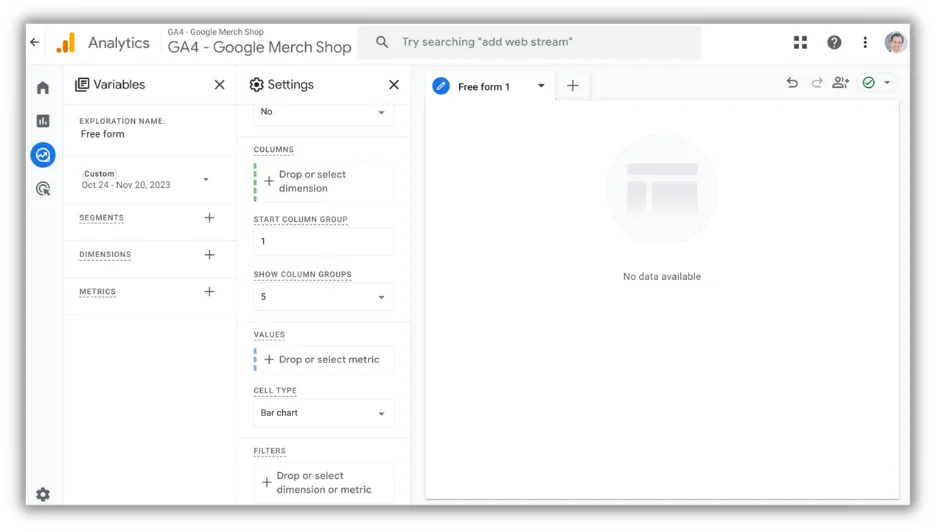

- Then head over to segments and click on the plus sign, here we’ll click on ‘User segment.’
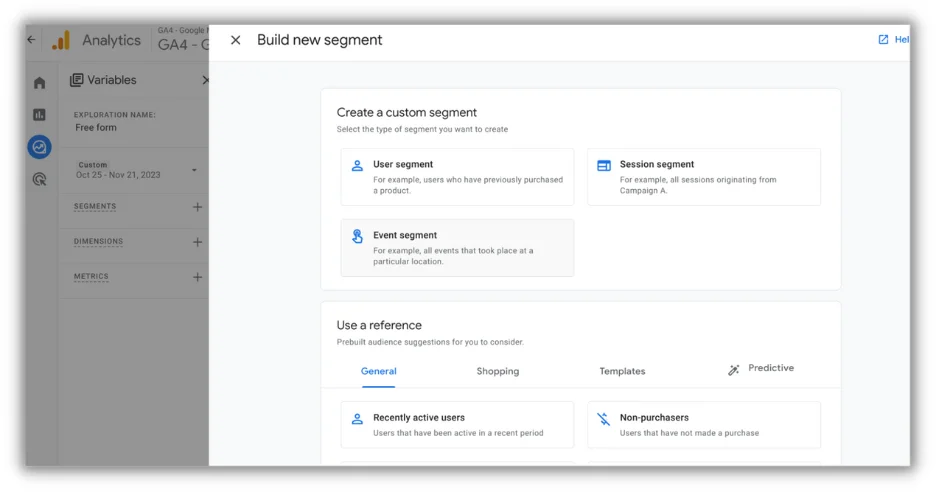

- Now, under ‘Add new condition,’ scroll to the bottom and you’ll see that there is an area called Predictive, clicking that will allow you to choose predictive metrics to segment your data by. Select Predicted Revenue and under filter, make sure ‘Most likely top spenders’ is checked, and then click ‘Apply.’
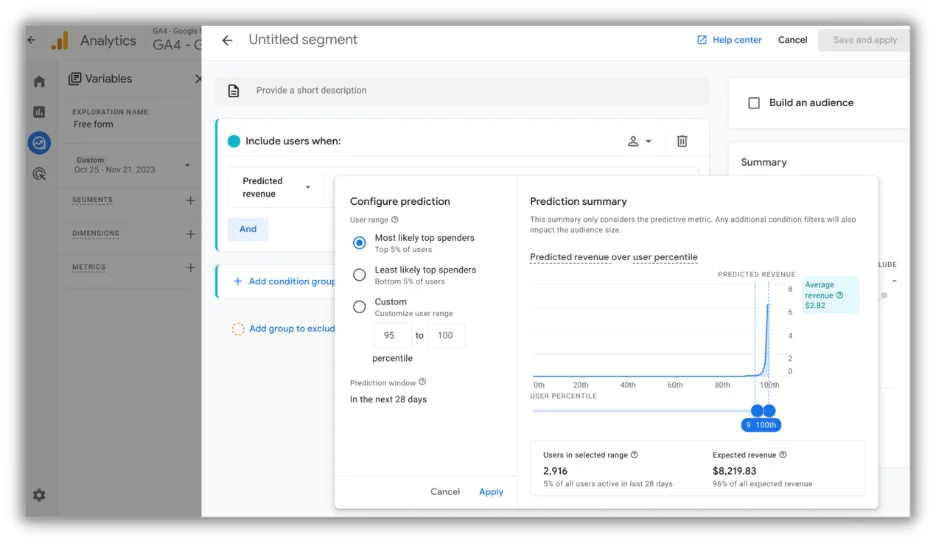

- Call your segment ‘Top Spenders (28 Day)’ and then click ‘Save’ and ‘Apply’ in the top right corner.
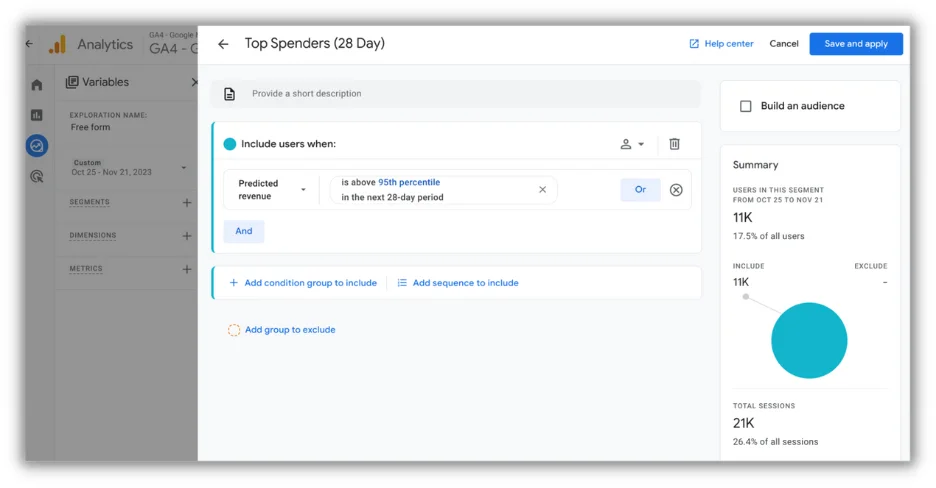

- Under ‘Dimensions,’ also add ‘First user source’ and ‘First user medium’ and under ‘Metrics’ and ‘Active users.’
- Add ‘First user source’ and ‘First user medium’ to rows. Also add ‘Active users’ to the values section.
- Change cell type to heat map. Your report should be structured to look like the following example:


This report offers a glimpse into the website analytics for the Google Merchandise Store, predicting the potential high-value customers in the upcoming month. The forecast relies on the user acquisition methods, such as direct web address input, referral from other websites, or email campaigns. Reports of this nature empower businesses by highlighting the most effective strategies for attracting valuable customers.
You can also add another segment for churn probability, which will look something like this:


Adding this as an additional segment provides insights into which groups and mediums are at a higher risk of not returning to the Google Merchandise Store within a week.
These categories might reflect reduced engagement or patterns previously associated with a lower likelihood of repeat visits or purchases. It also indicates that among the top spenders, there’s a subset of active users likely to not revisit the site.
Understanding these trends enables the store to customize retention strategies for these particular segments, aiming to decrease churn and boost ongoing engagement.
Use Google Analytics 4’s AI features
To sum up, Google Analytics 4 introduced powerful AI-driven features like predictive metrics and predictive audiences, which can be especially helpful in a future cookieless world. These tools enable marketers to target audiences effectively and gain insights into future user behaviors. Predictive audiences enhance advertising strategies, while predictive metrics, like purchase probability and churn probability, require specific prerequisites for effective use.
Additionally, integrating AI into reports, such as creating predicted channel value reports, enhances data analysis accuracy and highlights effective user acquisition methods and potential churn risks (as seen in the demo report we created). Leveraging AI in GA4 is essential for staying competitive and making data-driven decisions in the dynamic digital landscape.


















